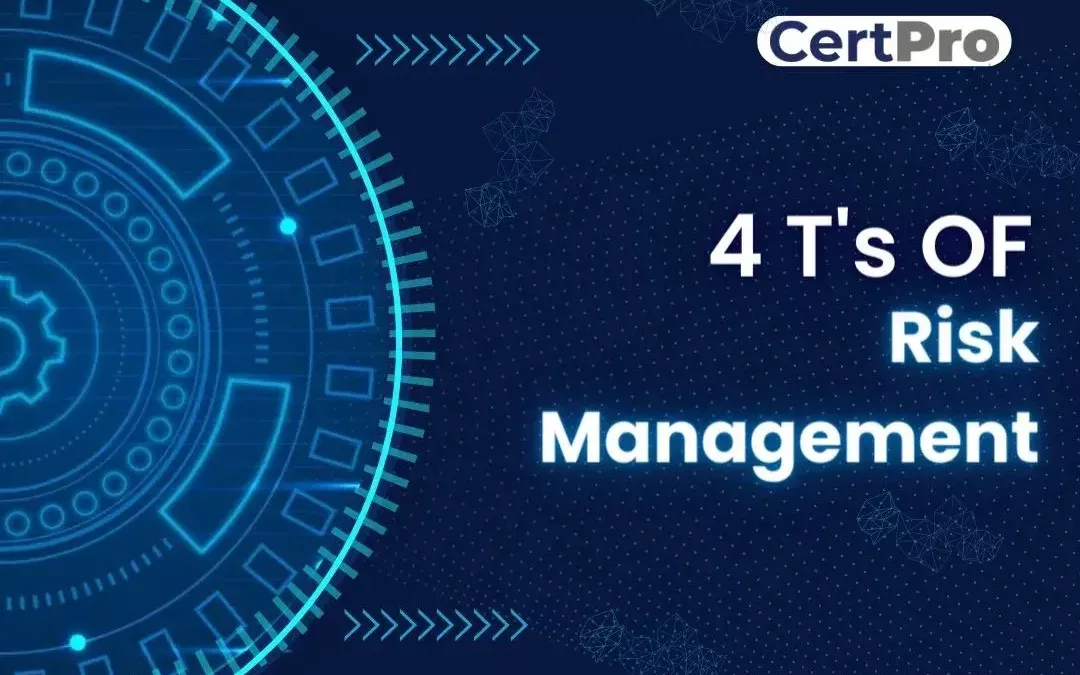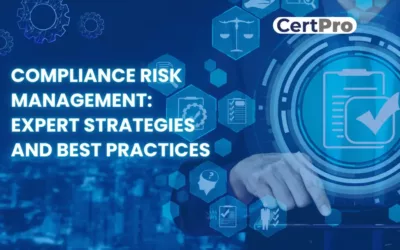Navigating the ever-shifting business landscape requires a keen understanding of the uncertainties that lie ahead. In today’s world, risk management has become the compass guiding organizations towards stability, success, and an unblemished reputation. Imagine a fortress with a strong framework that enables decision-makers to confidently face the unknown, protecting their long-term performance and ensuring sustainability.
To enter the realm of the “4 T’s,” a groundbreaking approach that tackles hazards head-on, leaving no stone unturned. Like skilled craftsmen, businesses can weave together a tapestry of risk detection, analysis, and action using four powerful threads: tolerate, terminate, treat, and transfer. It’s a symphony of strategies, harmonizing resilience and adaptability and orchestrating a symphony of success.
The article delves into the complexities of the four Ts, discussing what risk management is and how the four Ts of risk management provide a solid framework for detecting, assessing, and managing risks. Organizations may adapt to difficulties, seize on opportunities, and develop a strong foundation for long-term success by understanding the interaction of these aspects.
WHAT IS RISK MANAGEMENT?
Risk management is the systematic and proactive process of detecting, analyzing, and managing possible risks to an organization’s objectives. It entails examining uncertainties and vulnerabilities in order to reduce the negative implications of unfavorable occurrences while increasing the chances of positive outcomes.
The basic purpose of risk management is to safeguard and enhance an organization’s value and reputation by properly managing risks at all levels and functions. It is an essential component of strategic decision-making because it assists businesses in understanding possible risks, prioritizing them based on likelihood and effect, and developing methods to minimize or transfer those risks.
It includes a variety of actions. The process begins with the identification of possible risks through a thorough examination of internal and external elements such as operational procedures, market circumstances, legal and regulatory requirements, and developing trends.
WHY IS IT IMPORTANT TO IDENTIFY RISKS?
Risk identification is critical in risk management because it enables firms to be proactive rather than reactive. Organizations that recognize possible risks early on can establish effective ways to minimize or eliminate such risks before they appear and cause harm.
Here are a few techniques for identifying risks that are regularly used:

Risk Assessments: Conducting thorough risk assessments entails carefully assessing an organization’s processes, activities, and systems to identify possible vulnerabilities and hazards. This may be accomplished in a variety of ways, including interviews, surveys, observations, and documentation reviews.
SWOT Analysis: By assessing both internal and external elements impacting the firm, a SWOT (Strengths, Weaknesses, Opportunities, and Threats) study may assist in identifying hazards. Organizations might identify risks posed by rivals, market circumstances, regulatory changes, or other external variables by concentrating on the “threats” component.
Expert advice: Obtaining advice from subject matter experts inside the business or industry can assist in identifying risks that are particular to the activities or sector of the firm. Based on their knowledge and skill, these experts can give crucial insights, indicating hazards that others may ignore.
Risk Registers: Creating and maintaining a risk register or database can act as a central repository for recording and collecting recognized hazards. It offers a methodical strategy for tracking and monitoring risks, ensuring that they are regularly analyzed and managed throughout the business.
Organizations may proactively detect a wide variety of possible hazards by applying these strategies. This allows them to prioritize their activities, efficiently manage resources, and execute suitable risk mitigation techniques, thereby limiting the negative impact of risks on their operations, reputation, and overall performance.
DIFFERENT KINDS OF RISKS AND HOW TO AVOID THEM
There are various types of risks that may occur for organizations. Mentioned below are the risk management types:
Cybersecurity Risks: As firms rely more on digital systems and technology, cybersecurity risks have become an increasing concern. These dangers include hacking, data breaches, phishing attacks, ransomware, and unauthorized access to sensitive information. Cybersecurity risks can result in data loss, financial losses, legal obligations, and business reputational damage.
Financial risks: These types of risks involve uncertainty concerning an organization’s financial health and stability. Currency exchange rate changes, interest rate fluctuations, credit risks, liquidity risks, and investment risks are examples of such hazards. Financial risks can have an influence on a company’s profitability, cash flow, debt obligations, and capacity to raise money.
Operational risks: These are the risks that affect an organization’s internal processes, systems, and operations. They include operational risks such as human mistakes, process inefficiencies, supply chain interruptions, equipment failures, and IT system malfunctions. Financial losses, service interruptions, and reputational harm can all result from operational risks.
These are the types of risks that organizations might face. To mitigate these types of risks, here are a few key points an organization must follow:
1. Put in place strong cybersecurity measures, such as firewalls, encryption, and intrusion detection systems. Update and patch software and systems on a regular basis to resolve security flaws.
2. Use proper financial tools to hedge against currency or interest rate volatility. Conduct frequent financial analysis and stress testing to identify possible weaknesses and implement suitable mitigation measures.
3. Review and update operating processes on a regular basis to improve efficiency and identify possible vulnerabilities. To avoid system failures and interruptions, invest in proper technology, maintenance, and monitoring systems.
WHAT ARE THE 4 Ts, AND WHY SHOULD COMPANIES IMPLEMENT THEM?
The four key pillars or components that play a critical role in effective risk management are referred to as the four Ts” of risk management. These are the pillars:

Tolerate: When a company chooses to tolerate a risk, it indicates that it accepts the possible repercussions and decides not to take any particular action to minimize or prevent them. When the potential impact of the risk is relatively minimal or when the expense of controlling the risk outweighs the possible benefits, this technique is often adopted. Tolerating a risk does not imply completely ignoring it but rather closely monitoring it to ensure that it does not increase beyond tolerable limits.
Termination: Termination is the total elimination or avoidance of a risk by the discontinuation of the linked activity, undertaking, or process. When the discovered risk is judged intolerable or when the possible negative results outweigh the potential advantages, this technique is used. Organizations hope to eliminate the probability of the risk materializing entirely by terminating it.
Treat: Treating a risk means taking steps to limit, decrease, or manage its impact and possibility. This technique focuses on proactive risk management in order to reduce any negative effects. Implementing precautions, contingency plans, diversifying resources, or conducting training and awareness campaigns are examples of treatments. Risk management acknowledges their presence while attempting to decrease their impact to an acceptable level.
Transfer: Transferring a risk entails moving the risk’s possible effects to another person. Typically, this is accomplished through insurance policies, contracts, or outsourcing agreements. Organizations guarantee that if the risk materializes, the financial load or obligation falls on another business by transferring the risk. Risk transfer can assist firms in reducing their financial exposure and allocating resources more effectively.
Following the four T’s of risk management—tolerate, terminate, treat, and transfer—is critical for enterprises. It should be noted that these risk response tactics are not mutually exclusive, and a combination of strategies can be used depending on the individual conditions of each risk. Effective risk management necessitates a complete awareness of the risks involved, a rigorous evaluation of the available alternatives, and the adoption of suitable risk management measures.
INSIGHTS IN RISK MANAGEMENT
The four Ts of risk management provide a significant framework for businesses to successfully evaluate, analyze, and respond to risks. Each method—tolerate, terminate, treat, and transfer—provides a unique approach to risk management based on the possible effect and the risk tolerance of the company.
Tolerating risks is appropriate in cases where the possible repercussions of the risk are minor and the expense of mitigation outweighs the benefits. When a risk is considered intolerable, the linked activity or project is halted in order to eliminate the risk entirely. Treating risks means taking proactive steps to limit, lessen, or manage their influence, thereby minimizing potential negative outcomes. Finally, risk transfer allows firms to transfer the financial burden or duty to another party via insurance, contracts, or other means.
FAQ
How can businesses foster a solid risk management culture?
Fostering awareness, communication, and accountability at all levels of the business is essential for developing a solid risk management culture. Employees must be trained in risk management concepts, open communication about risks and their possible consequences must be encouraged, and risk management must be integrated into decision-making processes.
What are the disadvantages of each risk response strategy?
Tolerating a risk may result in unintended effects if the risk rises above acceptable limits. Terminating a risk may result in lost chances or the cancellation of potentially worthwhile ventures. Treating a risk may require large resources as well as regular monitoring.
Can we apply risk response techniques to a single risk?
Yes, numerous risk response techniques can be used for a single risk. Combining techniques may, in fact, give a more holistic approach to risk management.
How do I know which risk response technique to employ?
The cost-benefit analysis, risk tolerance, potential impact, and likelihood of the risk are just a few of the factors that go into choosing a risk response strategy. When deciding whether to tolerate, terminate, treat, or transfer a risk, consider the severity of the risk, the resources available, and the organization’s objectives.
Do the four Ts of risk management apply to all types of organizations?
Yes, the four Ts may be used for numerous sorts of businesses in various sectors. While individual hazards and situations may differ, the core risk assessment and response concepts remain relevant and applicable.

About the Author
SUBBAIAH KU
Subbaiah Ku is the Regional Director for CertPro in Oman, bringing a wealth of expertise in process and system auditing. As a seasoned lead assessor, Subbaiah is dedicated to ensuring the highest standards in compliance and security. His unique blend of technical acumen, rooted in Mechanical Engineering, is complemented by a diverse range of certifications and extensive training.
COMPLIANCE RISK MANAGEMENT: EXPERT STRATEGIES AND BEST PRACTICES
Compliance risk considers the organization's potential legal, material, and financial losses due to compliance failure. Thus, compliance risk is known as integrity risk. Organizations of all sizes are exposed to compliance risk. Hence, compliance failure results in...
TOP 7 DATA LOSS PREVENTION STRATEGIES IN 2024
In the contemporary business landscape, data is the cornerstone of organizational vitality. Businesses leverage data extensively to inform decisions, maintain competitiveness, and foster expansion. Nonetheless, they encounter multifaceted challenges emanating from...
TIPS FOR ARTICULATING YOUR SECURITY POSTURE TO STAKEHOLDERS
Cybersecurity is now a top-tier priority for any Organization. Data breaches can ruin the entire company, destroy customer trust, and damage reputation. However, companies can find decision-making difficulties because stakeholders, board members, department heads, and...




